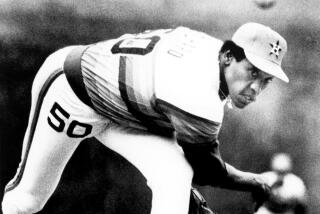Enjoying His Full-Time Role : Roy Smalley Is Staying Prepared and Producing Regularly as Twins’ Designated Hitter
- Share via
During his nine years as an infielder for the Minnesota Twins, New York Yankees and Chicago White Sox, Roy Smalley used to enjoy an occasional appearance as designated hitter.
For a guy who had to work so hard on his defense, just batting three or four times a game was as easy as a day off.
Now, Smalley has to work on his days off. He’s the Twins’ full-time designated hitter this year.
“It used to be kind of fun being the DH before, just sitting around and getting ready to hit,” Smalley said. “But doing it on a daily basis is more of an adjustment. I make sure I don’t sit around between at-bats. I run up and down the runway and watch what the pitcher is doing with the other hitters. It’s easy to get out of the flow of the game.”
Smalley seems to be settling into his new role as DH. Entering Friday night’s game against the Angels, he was the team’s leading hitter at .351 and was second in the American League in hits with 13, one behind Robin Yount’s 14.
His statistics as DH are good, and so is his attitude. Smalley, the nephew of Angel Manager Gene Mauch, could have been bitter about Twins Manager Ray Miller’s decision to replace him with light-hitting but good-fielding shortstop Greg Gagne.
It was management’s way of telling Smalley that his defensive skills were no longer good enough to keep his glove in the lineup. But he didn’t see his move to DH as a demotion.
“There comes a time in everyone’s career when you become an older, veteran player with specific talents that the team relies on,” said Smalley, who at 33 is the Twins’ second-oldest player behind pitcher Bert Blyleven. “I can’t play shortstop forever, but as long as I continue to get my chances at the plate, I’ll be happy.
“I like to play, but I like to hit the most.”
Smalley came out of USC in 1973 with a reputation as a good fielder and a weak hitter, but he has had some excellent offensive seasons in the major leagues.
Entering 1986, he had a career batting average of .257 with 135 home runs and 603 RBIs. His best season was 1979 with Minnesota, when he hit .271 with 28 homers and 95 RBIs and was voted the American League’s All-Star shortstop.
“For a skinny kid who supposedly couldn’t hit, I’ve done OK,” Smalley said.
The knock on Smalley defensively was that he had limited range, but he still managed to lead American League shortstops in assists, double plays and total chances for three consecutive seasons (1977-79).
“Putting people out is the name of the game,” Smalley said. “I never had great range, but I was around the ball a lot. I worked very hard at learning the hitters and what they do against different pitchers with different counts.”
These days, Smalley, a graduate of Westchester High School in Los Angeles, channels his thoughts almost exclusively toward hitting. And Miller likes what he sees.
“He seems so comfortable at the plate that I don’t want to move him,” Miller said. “He has a good routine. He runs up the ramp and into the clubhouse (in between at-bats). During long innings, I’ve seen him go the clubhouse and come back sweating.”
Smalley, a switch-hitter who was traded to the New York Yankees in 1982 and spent half of 1984 with the Chicago White Sox before returning to Minnesota in 1985, platooned with third baseman Gary Gaetti during spring training and led the team with four home runs.
But Miller wants Gaetti as his regular third baseman. Smalley also has played first base, but there isn’t much room on the Twins’ first-base depth chart with Kent Hrbek around.
Gagne, the second-year shortstop, is off to a 5-for-29 (.172) start, but Miller isn’t ready to give up on him yet.
“I don’t want him to feel if he doesn’t hit he’s not gonna play,” Miller said.
Smalley understands and remains happy with his role as DH.
“It’s too early to panic,” he said. “Everyone in this room is gonna go through a 1-for-20 streak. It’s just that when it comes at the start of the season, it looks bad. But that’s why they call it batting average. Everything averages out.”
More to Read
Go beyond the scoreboard
Get the latest on L.A.'s teams in the daily Sports Report newsletter.
You may occasionally receive promotional content from the Los Angeles Times.







